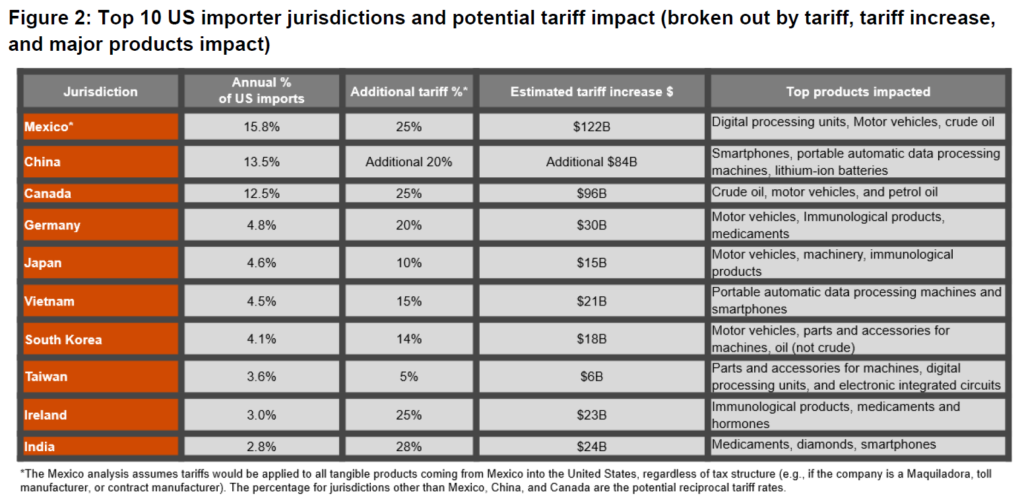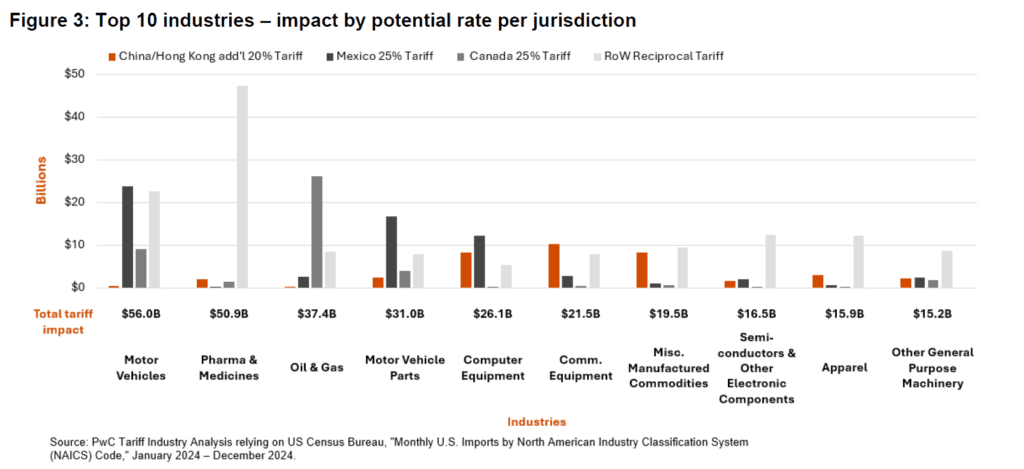Blog Content Overview
- 1 Introduction
- 2 Current India-U.S. Trade Relations and Opportunities
- 3 Current trade disruption owing to US imposition of tariffs and India’s Strategic Advantage
- 4 Key sectors poised to gain from the U.S. tariffs on China
- 5 U.S. Importer’s perspective – Costs, Tariffs & Compliance
- 6 Indian Exporter’s Perspective – Taxation, Duties & Incentives
- 7 External Perspectives: How the World is Reacting
- 8 Future Outlook: The Road Ahead for India
- 9 Conclusion
Introduction
In early 2025, the USA President Donald Trump announced a new wave of tariffs targeting major U.S. trading partners, including China, Canada, and Mexico1. These measures are designed to address long-standing trade imbalances and protect domestic industries. However, the immediate effect has been a disruption of global supply chains, prompting American businesses to look for alternative sourcing destinations.
China has historically played a dominant role in U.S. imports, amounting to $439 billion in 2024—down from $505 billion in 2018—reflecting a steady decline that the 2025 tariffs have accelerated2. The newly imposed 20% tariff on all Chinese imports in February 20253 has accelerated this shift and we need to bring out the acceleration of the decline. Among the potential beneficiaries, India emerges as a strong contender, thanks to its growing manufacturing sector, improving ease of doing business, and strategic government initiatives.
This article examines India’s positioning as a viable alternative to China in U.S. imports, analyzing the opportunities, challenges, and strategic implications of this shift.
Current India-U.S. Trade Relations and Opportunities
India-U.S. Bilateral Trade Statistics
India and the U.S. share a strong trade relationship, with total bilateral trade reaching $191 billion in 2024, marking a steady rise from $146 billion in 2019. The U.S. is India’s largest trading partner, accounting for approximately 17% of India’s total exports. (Source: USTR, Ministry of commerce)
| Year | India’s Exports to U.S. (in Billion $) | India’s Imports from U.S. (in Billion $) | Total Bilateral Trade (in Billion $) |
| 2019 | 54 | 35 | 89 |
| 2022 | 76 | 48 | 124 |
| 2024 | 98 | 83 | 191 |
Comparison of key sector exports by India to US vis-a-vis China to US
Below table showcases comparison of historical data related to key sector exports by India to US vis-a-vis China to US:
| Sector | India’s Exports to U.S. (2024) (in Billion $) | China’s Exports to U.S. (2024) (in Billion $) |
| IT & Software Services | 35 | 70 |
| Pharmaceuticals | 22.5 | 75 |
| Textiles & Apparel | 9.2 | 34 |
| Automotive Components | 18.3 | 48 |
| Electronics | 13 | 140 |
India’s growing share in these critical sectors positions it as an ideal trade partner for the U.S., particularly as tariffs on Chinese goods push American companies to look for new suppliers.
Current trade disruption owing to US imposition of tariffs and India’s Strategic Advantage
U.S.-China Trade War and Its Ripple Effect
The U.S.-China trade relationship has seen turbulence for years, with tariffs and counter-tariffs disrupting supply chains. The latest tariff escalation adds to the strain, making American companies more cautious about relying on Chinese suppliers. This has fueled a growing interest in India as a manufacturing and export hub.
Projected Tariff Impact on U.S. Imports
| Year | Total U.S. Tariffs (in Billion USD) |
| 2024 | USD 76 billion |
| 2025 (Projected) | USD 697 billion – of which $273 billion would be derived from ‘Dutiable’ goods and $424 billion from ‘Non-dutiable’ goods—reflecting a shift from zero tariffs on these products |
Source: Impact of US tariffs
Many U.S. multinationals have structured their supply chains around Free Trade Agreements (FTAs). As a result, the imposition of tariffs on previously “non-dutiable” goods could significantly disrupt their sourcing strategies. According to a report on the U.S. tariff industry analysis, these tariffs disproportionately impact sectors such as industrial products, pharmaceuticals, automotive, and consumer electronics. This shift presents a strategic opportunity for India to strengthen its position in U.S. supply chains.
The following figure4 provides a detailed breakdown of the top 10 U.S. importer jurisdictions, highlighting tariff rates, recent increases, and the major product categories affected:

To analyze the current vs. proposed tariff state, the below figure5 summarizes the prospective annual impact for the top industries with the largest incremental increase of potential tariffs:

India’s Growing Manufacturing Ecosystem
India has made significant strides in manufacturing, driven by the “Make in India” initiative. Despite a modest production growth rate of 1.4% in FY 2023-24 compared to 4.7% in the previous fiscal year6, the government remains committed to expanding the sector’s contribution to Gross Value Added (GVA) from 14% to 21% by 20327.
Key policies such as the Production-Linked Incentive (PLI) scheme have attracted over $17 billion in investments, spurring production worth $131.6 billion and creating nearly one million jobs in just four years8.
Business-Friendly Environment
“India improved its global standing in the past, ranking 63rd out of 190 countries in the World Bank’s Doing Business Report 2020910. This is the result of pro-business reforms, including:
- Liberalization of foreign investment rules
- Modernized Insolvency and bankruptcy laws
- Elimination of retrospective taxation
- Jan Vishwas (Amendment of Provisions) Act, 2023, which decriminalized 183 provisions across 42 Central Acts11
- Introduction of beneficial taxation regime for newly started manufacturing companies
Workforce availability & skill development
With a labor force exceeding 500 million, India provides an abundant and cost-effective workforce. The non-agricultural sector alone added 11 million jobs from October 2023 to September 2024, bringing total employment in this sector to 120.6 million12.
To further enhance workforce readiness, the Indian government is investing heavily in skill development programs to align with industry needs.
Key sectors poised to gain from the U.S. tariffs on China
Electronics & Manufacturing
India’s manufacturing sector has been experiencing steady growth, with manufacturing GDP increasing from $327.82 billion in 2015 to $440.06 billion in 202213. The Production-Linked Incentive (PLI) scheme has played a crucial role in accelerating this growth, particularly in electronics manufacturing. A report highlights that companies like Foxconn and Samsung are set to receive over ₹4,400 crore under the smartphone PLI scheme, indicating significant investments and expansions in India’s electronics manufacturing sector14. India is benefiting from U.S. import diversification, and reports also highlight that disruptions in semiconductor and communication equipment imports from China could create significant opportunities for India in certain sectors.
Information Technology (IT) and Software Services
India’s Information Technology (IT) exports have continued their upward trajectory in the fiscal year 2023-24. According to the Press Information Bureau (PIB), India’s services exports, which encompass IT services, reached approximately $341.1 billion15 in 2023-24. The United States is India’s largest IT services market, and with trade restrictions on China, U.S. firms are increasingly turning to Indian companies for solutions in:
- Artificial Intelligence (AI) and automation
- Cloud computing and cybersecurity
- Enterprise software development
India’s IT giants, including TCS, Infosys, and Wipro, are strengthening their digital transformation capabilities to meet rising demand from U.S. businesses.
(Source: Statista, Moneycontrol)
Pharmaceuticals
India has long been regarded as the “pharmacy of the world”, with pharmaceutical exports growing significantly. Some key pharmaceutical trade statistics are given below:
- Export Value (2023-24): $27.85 billion
- API Market Growth: 12% CAGR
- U.S. Dependency on China: India exports antibiotics and APIs, but China still holds a dominant share (95% ibuprofen, 91% hydrocortisone, 70% acetaminophen)
While specific data on above API exports is limited, India’s overall antibiotics exports have been significant. In 2023, antibiotics constituted approximately 0.233% of India’s total exports, amounting to around $1 billion.
The U.S. heavily relies on China for active pharmaceutical ingredients (APIs), but recent restrictions on Chinese pharmaceutical imports have pushed American firms to seek alternative suppliers. India, with its cost-effective drug manufacturing capabilities and stringent quality standards, is well-positioned to fill this gap.
(Source: PIB, Bain, Reuters, Prosperousamerica, Trend economy)
Textiles & Apparel
In the financial year 2023-24, India’s textiles and apparel exports, including handicrafts, was $35.87 billion which is a significant portion of India’s overall exports. The ongoing U.S.-China trade tensions have prompted global retailers to diversify their supply chains, and India, with its strong cotton and synthetic fiber production, is emerging as a key beneficiary.
Additionally, India’s share of global trade in textiles and apparel stands at 3.9%, with major export destinations including the USA and the European Union, accounting for approximately 47% of total textile and apparel exports.
Several multinational brands have started shifting their sourcing operations to India, further boosting exports in this labor-intensive sector. (Source: Ministry of textiles, PIB)
Automotive Components
India’s auto component exports ($21.2 billion in 2023-24) are growing, but tariffs on Mexico (100 to 200% on some auto goods) are expected to have the most severe impact on the U.S. auto supply chain. The industry’s expansion reflects its resilience and adaptability, with exports increasing from $10.8 billion in 2015 to $21.2 billion in 2023-24.
With U.S. tariffs on Chinese auto parts, Indian manufacturers are gaining a competitive edge. India has already established itself as a leading supplier of engine components, braking systems, and electrical parts for major U.S. automakers. If India continues enhancing its production capacity and quality standards, it could capture a significant share of the U.S. auto parts market.
(Source: India briefing, ACMA)
U.S. Importer’s perspective – Costs, Tariffs & Compliance
Tariffs on Indian Imports
- Understanding Tariff Classifications: U.S. importers must classify Indian goods under the Harmonized Tariff Schedule (HTS) to determine duty rates.
- Most-Favored-Nation (MFN) vs. Additional Duties: Indian goods are generally subject to MFN rates but may attract anti-dumping duties in some cases.
- Avoiding Additional Tariffs: Importers can benefit from tariff exclusions available under the Generalized System of Preferences, which remains suspended for India as of 2025, but may be reinstated pending negotiations.
U.S. import & customs compliance
- Customs Documentation: Importers must file following documents:
- Commercial Invoice
- Packing List
- Bill of Lading / Airway Bill
- Certificate of Origin (preferably digitally signed)
- Importer’s Customs Bond (in the US)
- FDA/USDA Clearance (for food, beverages, cosmetics, pharmaceuticals, agri goods)
- Lacey Act Declaration (for wood, paper, plants)
- Time for Customs Clearance: Sea shipments take 5-7 days at ports like Los Angeles; air shipments clear in 1-3 days.
Regulatory & Compliance Requirements
Depending on the product category, several US federal agencies may require additional clearances:
- The FDA (Food & Drug Administration) governs imports of food, cosmetics, drugs, medical devices, and dietary supplements. Prior notice and facility registration may be required.
- The USDA (Department of Agriculture) and APHIS monitor animal-origin or plant-based goods.
- The CPSC (Consumer Product Safety Commission) sets safety rules for toys, electronics, household goods, etc.
- The FCC regulates electronic goods with wireless or radio frequency components.
- The EPA handles goods containing chemicals or pollutants.
Additionally, under the Lacey Act, importers must declare wood or plant-based product origins (e.g., wooden furniture, paper).
Also, if you’re importing chemicals, ensure compliance with TSCA (Toxic Substances Control Act) by submitting the required certifications.
Logistics & Supply Chain Challenges
- Freight Costs: Container shipping from India to the U.S. costs $4,000–$6,000 per 40-ft container.
- Port Congestion Risks: Delays at major U.S. ports can add 7-14 days to shipping times.
Taxation for U.S. Importers
- State-Specific Taxes: Certain states levy additional import processing fees.
- Transfer Pricing Compliance: If importing from an Indian subsidiary, IRS requires arms-length pricing.
Indian Exporter’s Perspective – Taxation, Duties & Incentives
Income Tax for Exporters
Basic tax rate of 22% for companies, 15% for new manufacturing firms.
GST on Exports & Refund Process
- GST is Zero-Rated for exports, meaning exporters can claim full refunds.
- Letter of Undertaking (LUT) Filing: Required to export without paying GST upfront.
- How to Apply? Log into the GST portal → Select “Services” → Choose “User Services” → File LUT.
- Deadline: LUT must be filed before the start of the fiscal year.
- Common Refund Delays: ITC mismatches, incorrect bank details, missing supporting documents.
Export Duties & Government Incentives
- RoDTEP (Remission of Duties and Taxes on Exported Products): Refunds 2-5% of FOB value.
- Duty Drawback Scheme: Exporters get a refund on customs duties paid on inputs.
- PLI Scheme: Government provides financial incentives to exporters in electronics, textiles, and pharma.
Forex & Banking Regulations
- Export Payment Realization: As per RBI, exporters must receive payment within 9 months from the date of shipment.
- Letter of Credit (LC) vs. Open Account: LCs provide payment security but require bank guarantees.
- Hedging Forex Risk: Exporters can use forward contracts to protect against rupee depreciation.
Customs Clearance & Logistics in India
- Time for Export Clearance: Air shipments clear in 1-2 days, while sea shipments take 3-5 days.
- DGFT Compliance: Exporters must register with the Directorate General of Foreign Trade (DGFT) and obtain an Import Export Code (IEC).
Further, if the payment is on account of royalties, technical services, software access, or licensing fees, then US tax laws under Section 1441 may apply. In such scenarios, the Indian exporter would have to furnish a Form W-8BEN (in case of individuals) or W-8BEN-E (in case of entities) in order to avail US-India Double Taxation Avoidance Agreement (DTAA) benefits.
External Perspectives: How the World is Reacting
- Trade Diversion Effects: During the 2017–2019 U.S.- China trade war, India emerged as the fourth-largest beneficiary of trade diversion, with exports to the U.S. increasing from $57 billion in FY18 to $73 billion in FY19. A similar trend is expected in 202516.
- Exporter Sentiment: Indian exporters report a rise in orders, indicating shifting trade preferences.
- Stock Market Reactions: Short-term volatility has been observed, but long-term prospects remain strong.
- Diplomatic Engagements: India nears the global average in trade relationships, reflecting its broad connections with Asia, Europe, and the United States. This diversified trade network underscores India’s potential to strengthen its position in global trade realignment17.
- Vietnam and Indonesia have experienced significant surges in FDIs as manufacturers shift operations away from China18. However, India is also leading FDI inflows and the same is evident from cumulative FDI inflow of $667.4 billion between 2014 and 202419.
Future Outlook: The Road Ahead for India
The global trade realignment presents a unique opportunity for India to emerge as a critical manufacturing and export hub. However, to fully capitalize on this shift, continued investment in infrastructure, regulatory simplifications, and supply chain improvements are necessary.
With strategic planning and collaboration between the government and industries, India can cement its role as a reliable trade partner for the U.S., fostering economic growth and deeper bilateral ties.
Conclusion
India stands at a pivotal moment in global trade realignment. With proactive policies, strong sectoral growth, and a favorable geopolitical environment, the country is well-positioned to replace China in several U.S. import categories. The coming years will be critical in shaping India’s trajectory as a global manufacturing powerhouse.
References:
[1] https://www.whitehouse.gov/fact-sheets/2025/02/fact-sheet-president-donald-j-trump-imposes-tariffs-on-imports-from-canada-mexico-and-china/ ↩︎- [2] https://libertystreeteconomics.newyorkfed.org/2025/02/u-s-imports-from-china-have-fallen-by-less-than-u-s-data-indicate/ ↩︎
- [3] https://www.whitecase.com/insight-alert/us-tariffs-canada-and-mexico-enter-effect-tariff-china-rises-10-20/ ↩︎
- [4] https://www.pwc.com/us/en/tax-services/publications/insights/assets/pwc-us-tariff-industry-analysis-private-equity.pdf ↩︎
- [5] https://www.pwc.com/us/en/tax-services/publications/insights/assets/pwc-us-tariff-industry-analysis-private-equity.pdf ↩︎
- [6] https://www.india-briefing.com/news/india-manufacturing-tracker-2024-25-33968.html/ ↩︎
- [7] https://economictimes.indiatimes.com/news/economy/indicators/indias-manufacturing-sectors-contribution-to-gva-will-surge-to-21-by-2032-from-14-now-report/articleshow/116793951.cms ↩︎
- [8] https://www.reuters.com/world/india/indias-manufacturing-incentives-progress-amid-efforts-cut-china-imports-2024-09-25/ ↩︎
- [9] Note: The World Bank has since replaced the Doing Business Report with the Business Ready (B-READY) report, launched in October 2024. However, as of April 2025, a comparable global ranking for India under this new framework is not yet available. ↩︎
- [10] https://www.makeinindia.com/india-jumps-14-places-world-banks-doing-business-report-2020 ↩︎
- [11] https://pib.gov.in/PressReleaseIframePage.aspx?PRID=2003540 ↩︎
- [12] https://www.reuters.com/world/india/indias-small-businesses-added-11-million-jobs-202324-2024-12-24 ↩︎
- [13] https://www.macrotrends.net/global-metrics/countries/ind/india/manufacturing-output ↩︎
- [14] https://www.business-standard.com/industry/news/foxconn-apple-samsung-to-receive-rs-4-400-cr-under-smartphone-pli-scheme-124030400126_1.html ↩︎
- [15] https://pib.gov.in/PressReleasePage.aspx?PRID=2098447 ↩︎
- [16] https://blog.lukmaanias.com/2025/02/11/the-impact-of-trumps-trade-war/ ↩︎
- [17] https://www.mckinsey.com/mgi/our-research/geopolitics-and-the-geometry-of-global-trade ↩︎
- [18] https://www.mckinsey.com/industries/logistics/our-insights/diversifying-global-supply-chains-opportunities-in-southeast-asia ↩︎
- [19] https://pib.gov.in/PressReleasePage.aspx?PRID=2058603 ↩︎
We Are Problem Solvers. And Take Accountability.
Related Posts

IFSCA Regulatory Newsletter – April 2025 to November 2025
The International Financial Services Centres Authority (IFSCA) has demonstrated exceptional regulatory dynamism during the April-October 2025 period, introducing transformative frameworks...
Learn More

VCFO for Exit Strategy – Role in Financials, Equity and M&A
Every business owner will eventually navigate a liquidity event. The choice of exit strategy whether an Initial Public Offering (IPO),...
Learn More

Important Financial timelines before 31st March 2026
As the financial year 2025–26 closes, taxpayers whether individuals, startups, small businesses, or companies must complete several statutory and tax-related...
Learn More













